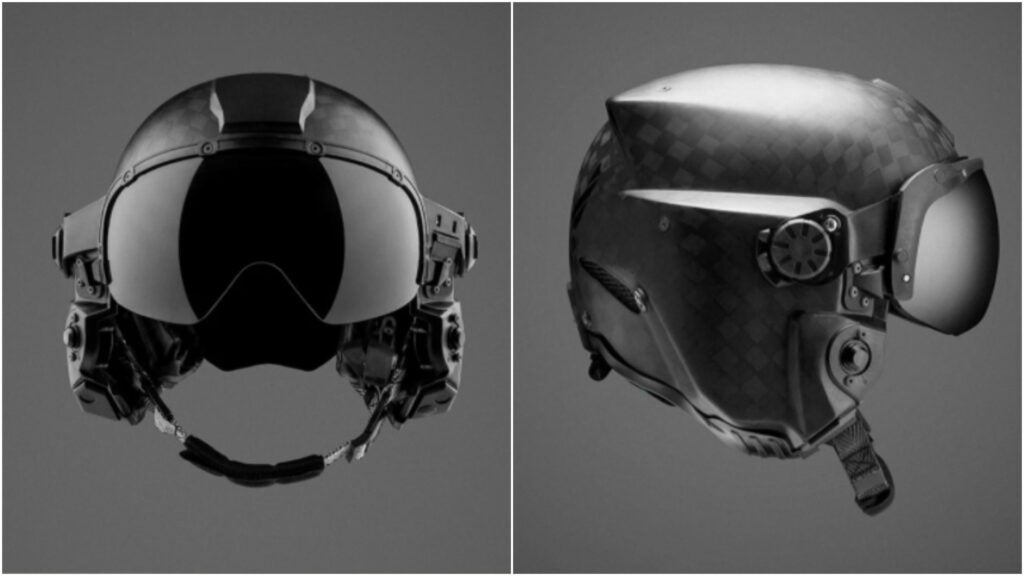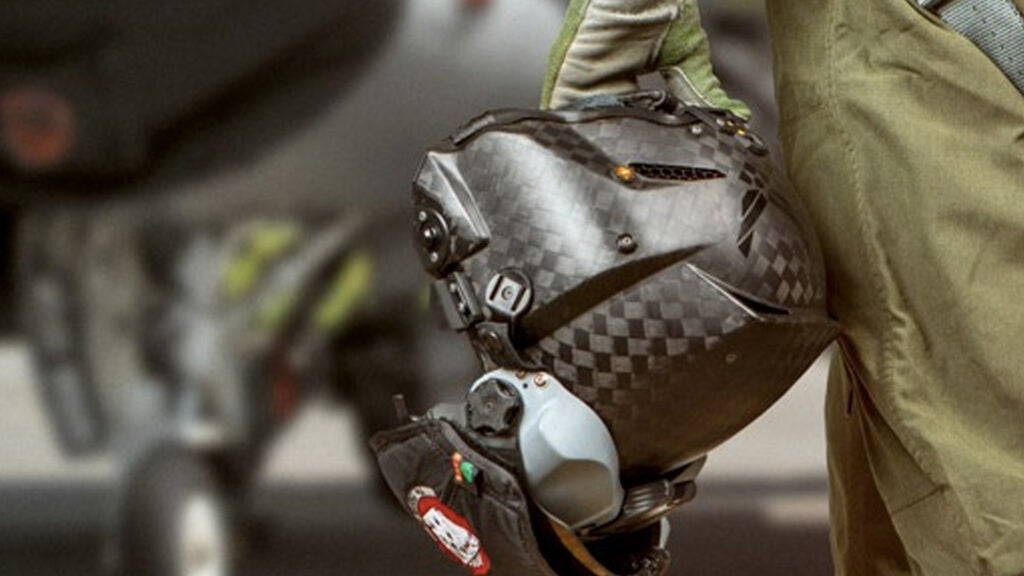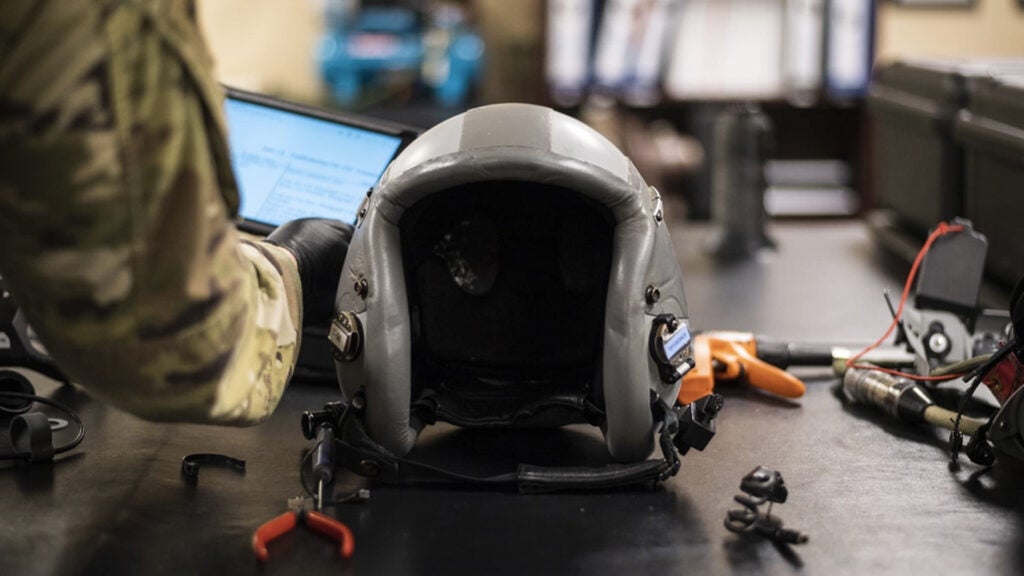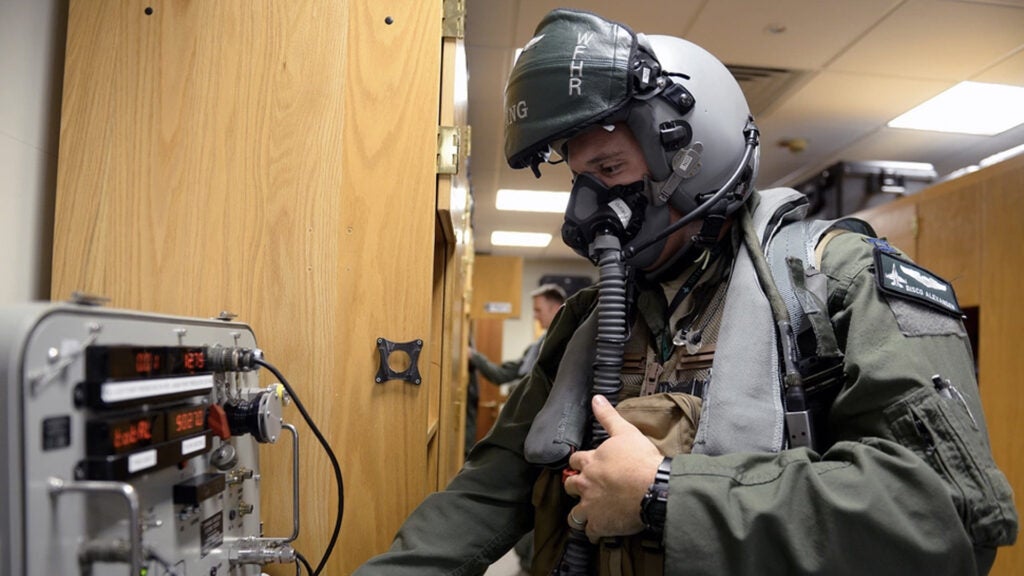Pilots of fixed-wing Air Force aircraft have been wearing the same helmet for nearly 40 years, but that could soon change with a new brain bucket that’s lighter, more comfortable, more adaptable and better ventilated than its predecessor, the HGU-55/P.
“It’s been 40 years since we’ve had the 55/P, so there’s been a lot of room for improvement,” said Maj. Justin “Hasard” Lee in a video about the Next Generation Fixed Wing Helmet on his YouTube channel earlier this month.
“Everything about this helmet has been designed from the pilot’s perspective, so finally we have a modern helmet to go with these modern fighters,” Lee said.
[embedded content]
An F-35 pilot with years of experience flying the F-16 fighter jet, Lee had a few gripes about the old-school 55/P, which is worn by many fighter, bomber, transport and tanker pilots across the service. Lee’s first grievance? The weight, which, according to manufacturer Gentex, is 2.2 pounds. Though that sounds light, any number of pounds sitting on your head can really add up when you’re pulling nine times that weight in a high-G maneuver. The average weight of a human head is about 10 or 11 pounds, so that, plus the helmet, equals about 120 pounds or more of weight sitting on your neck at nine Gs.
“Not only is that uncomfortable to be under nine Gs when you’re flying, but the biggest issue is later in your career when pilots start having neck and back issues,” Lee said. “I know unfortunately a lot of pilots that have had to be medically retired because of that.”
It’s no joke: according to a 2012 study, 72% of surveyed Royal Norwegian Air Force pilots experienced neck pain in relation to flying, while 35% experienced back pain. Neck rotation was a major cause of grief for the pilots, particularly “checking six,” meaning to look behind them, the study found. To help keep its dwindling number of fighter pilots in the service, the U.S. Air Force actually contracts athletic trainers, strength coaches and massage therapists to help pilots better prepare their bodies for the strain of G-force.
“The idea behind the program is the preventive maintenance,” said F-15C pilot Maj. Clayton “Red Beard” Cruichshank about a physical training program at Nellis Air Force Base in April. “Rather than waiting until someone has a back or neck problem, we’re already training to be stronger before problems occur, so we’re better able to handle the stresses.”

Any little loss of weight in the helmet also helps, Lee said. While the website of the helmet manufacturer, LIFT Airborne Technologies, did not state the exact weight of the Next-Generation Fixed Wing helmet, Guido Rietdyk, the company’s president, said the goal “is to have the helmet not exceed 2.2 lbs in any size or configuration.”
That can make a big difference, because pilots have a lot of gear they need to put on their helmets in order to do their jobs. For example, fighter pilots use the Helmet Mounted Cueing System, which shows flying and targeting data on a heads-up display on the pilot’s visor. For night flying, they also wear night vision goggles, but switching between the two with the old helmet was a real headache.
“I’ve flown a lot of night combat missions,” Lee said. “The thing was, you’d fly with the HMCS, until it got dark, you’d have to take off the helmet, take off the HMCS system, put on a bracket, put on your night vision goggles, and so that was a whole process.”
That’s a problem when you’re flying a close air support mission for ground troops under fire who don’t have time for you to adjust your head gear.
“That’s time you’re taking away from the troops on the ground,” Lee said. “So being able to streamline that process is important.”
The Next Generation Fixed Wing Helmet makes it easy to attach the NVGs, with no extra bracket required, Lee said. That modularity is important because the new helmet is meant to stick with pilots throughout their career, from pilot training to whichever aircraft they are assigned to. Most pilots wear the current 55/P throughout their career too, but not all of them are happy about it.
“The current 55/Ps are terrible!” one C-17 cargo jet pilot told Task & Purpose. The pilot spoke on the condition of anonymity since he was not authorized to speak with the press.
“Mine has never fit right since pilot training,” he added. On top of that, the old helmets are swampy pits after a long flight.
“They don’t breathe at all,” he said. “It’s a huge relief when we get to take off the helmet after a flight or during pilot swap out.”

Unlike fighter pilots, who wear their helmets every time they get in the cockpit, C-17 drivers don’t have to wear their headgear all the time. The pilot explained that he usually wears his “to mount NVGs for night flying,” though occasionally “we will wear them during daytime in a combat zone to protect against debris should the cockpit take a direct hit.” The 55/P can’t stop bullets, but it might stop penetration from debris, the pilot said.
A navigator aboard a WC-130J weather reconnaissance plane shared his opinion of the old helmets.
“For me it doesn’t fit great around the ears so it doesn’t do a great job with isolating noise,” said Lt. Col. Mark Withee, a navigator with the 53rd Reconnaissance Squadron. “After a while it’s also pretty uncomfortable with the way it’s squishing my head.”
Like the C-17 pilot, Withee and his fellow WC-130J aviators don’t have to wear helmets very often, but when they do, it’s not the most pleasant experience.
“The old ones aren’t built with any ventilation, so in hot environments your head gets sweaty pretty quickly,” Withee said. While some people wear cloth skull caps to keep the helmet pads from getting gross with sweat, Withee reasoned that they’re just another layer of fabric insulating your head on a hot day. Of course, that insulation can be a godsend in cold environments. Withee recalled standing near the back of a WC-130J over the North Pacific in January at 5,000 feet up, where the temperature was negative 15 degrees with high winds whipping by.
“The only part of me that wasn’t cold was my head. But that was sort of a special circumstance,” the navigator said.

Between the tight fit and the lack of ventilation, the 55/P has its flaws, but the Next Generation Fixed Wing Helmet seems to put several of those to rest. Unlike its predecessor, the NGFWH actually has vents in the back to get that sticky air out of your hair.
“Out here in Phoenix, temperatures get up to about 120 degrees on the ramp,” Lee said. “And we’re not dressed for the heat. We have on a G suit, which is like snowpants.”
Lee said in an earlier interview with Task & Purpose that pilots lose a lot of water before they even get in the cockpit, like when they’re walking across the desert flight lines of the Middle East or the humid ramps of Florida or South Carolina. But the cockpit is not much better.
“The air conditioner doesn’t work that well until you’re flying because it’s using all the A/C to cool the mission systems like the radar,” Lee said. “Unfortunately the pilot gets left out of the loop on that.”
The heat is more than just an inconvenience: it’s a safety hazard. According to one study from 1979, just 3 percent dehydration can reduce a pilot’s G tolerance by 40 percent. If your tolerance to G-forces goes down, you can’t take the high-speed turns of aerial maneuvering and you’ll be more likely to black out from G-induced loss of consciousness. With that in mind, “anything you could do to save the heat,” like a helmet that actually vents out hot air, “is great,” Lee said.
Temperature aside, just wearing a poorly-fitting helmet can be a nuisance, as the C-17 and WC-130J aviators mentioned earlier. But the NGFWH might fix that, too. Lee pointed out that the new bucket has a few knobs for adjusting various parts of the headwear so it fits just right. The pilot also custom-fitted the helmet on his own using an in-depth app that comes with it, he said.
However, the fit of the helmet is about more than just creature comfort. Having a helmet jostle around in the middle of a mission could be an unwelcome and potentially dangerous distraction. There are also certain heads-up display tools such as the Helmet Mounted Cueing System, where the pilot’s eyes have to be centered properly for him or her to see the signals within.
“They actually did a great job,” Lee said of the NGFWH. “The helmet has this dynamic fit system which means it’s a lot more comfortable than the old helmet.”

Convenience, comfort and mission preparedness go hand-in-hand and all the way down in the NGFWH. Lee said his favorite feature of the new helmet is a pair of lights mounted to its sides. Those lights help with reading maps or other documents inside the cockpit, but that’s not the cool part. The cool part is how you turn it on. In the past, pilots brought flashlights to read flight documents, but that meant they had to take a hand off their flight controls to hold the flashlight. Some pilots tried strapping lights to their fingers, or wearing tongue-activated lights on their oxygen masks, but Lee found those solutions clunky or unappealing.
Unlike those past ideas, the next-gen helmet is activated by a button which gets pressed by the pilot’s jaw muscles when he or she clenches their jaw. There are different activation settings pilots can choose, but Lee demonstrated using a short clench, followed by a long clench, to activate the pair of lights on his helmet.
“I was skeptical about this at first, but it actually works surprisingly well,” Lee said. “It’s probably the best solution that I’ve found to lighting up the cockpit.”
There’s one last thing that Lee and other aviators said they appreciated about the Next Generation Fixed-Wing Helmet. It’s a feature many civilians have become accustomed to when they put on their AirPods: noise cancellation. Except instead of blocking out loud street noises, pilots want to block out the engine roaring around them in the cockpit.
Noise cancellation is “huge,” Lee said. “We’re flying six, eight hour missions in combat, so anything you can do to reduce the stress is important.”
Withee echoed that sentiment.
“What would be really nice is noise canceling,” the C-130 “Hercules” engine noise, the navigator said. “At least in the Herk the David Clark or Bose noise cancelling headsets make a big difference. It sucks going on helmet and not having that.”
With so much high praise, you might expect the Air Force to have bought a bunch of the Next Generation Fixed-Wing Helmets in bulk by now, but that hasn’t happened yet.
Guido Rietdyk, the president of LIFT Airborne Technologies, which created the NGFWH, said testing is scheduled to complete in late 2023, with a production contract to commence sometime in 2024. The process to find a new helmet has been going on for some time now. The Air Force started taking crowd-sourced user suggestions back in 2018, and private companies ran with the ideas from there.
Originally, more than 100 concepts were in the running, Rietdyk said, but now just two remain: LIFT and GenTex, the maker of the 55/P, which has a next-generation helmet in the race.
The NGFWH is currently being tested by F-22 fighter pilots, Lee said, with B-1 bomber pilots next on the list.
“It’s big,” Lee said. “Every little piece of equipment you have, you want to make sure it’s updated so you can be as lethal and capable as possible. They’ve gone through this helmet and made everything seamless for the pilot.”
More great stories on Task & Purpose
Want to write for Task & Purpose? Learn more here and be sure to check out more great stories on our homepage.
